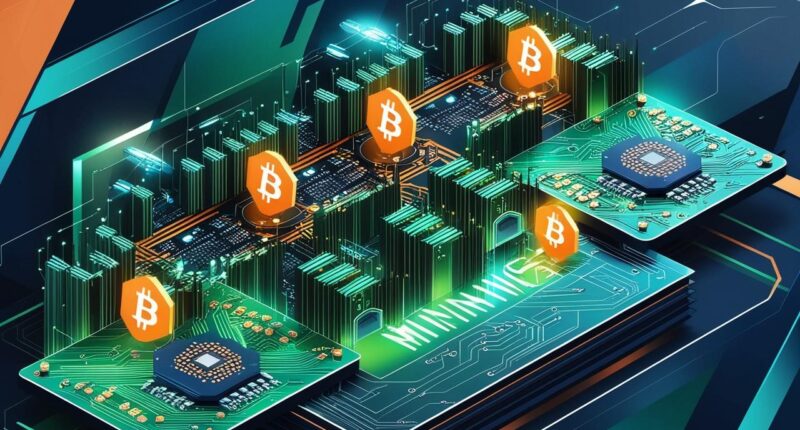Mining in cryptocurrency is the process of validating transactions and maintaining the blockchain. Miners use specialized hardware, such as Application-Specific Integrated Circuits (ASICs) or Graphics Processing Units (GPUs), to solve complex puzzles. The first miner to solve the puzzle adds a new block to the blockchain and is rewarded with newly minted cryptocurrency. Energy consumption is significant, raising environmental concerns. Miners often join pools to increase their chances of earning rewards, and profitability depends on various factors. More insights are available on the mining process.
Mining in cryptocurrency refers to the process of validating transactions within a decentralized network, which is crucial for maintaining the integrity of the blockchain ledger. This process involves adding new blocks to the blockchain while simultaneously securing the network. Miners validate transactions and prevent issues like double-spending, ensuring that the same digital currency cannot be used twice. Additionally, mining introduces new coins into circulation, which is essential for many cryptocurrencies.
To mine effectively, miners utilize specialized hardware. The most common types include Application-Specific Integrated Circuits (ASICs) and Graphics Processing Units (GPUs). Central Processing Units (CPUs) have become largely obsolete for most cryptocurrencies. Mining rigs often combine multiple GPUs to increase processing power, and these setups frequently require specialized cooling systems to manage heat generated during operation.
The mining process itself involves solving complex cryptographic puzzles. Miners compete to find a correct hash value, and the first to solve the puzzle adds a new block to the blockchain. In return, they receive newly minted cryptocurrency as a reward. The network adjusts the difficulty of these puzzles regularly to maintain a consistent time for block creation. Mining difficulty is a critical factor that ensures the network remains secure and prevents any single entity from gaining too much power in the mining process. However, mining operations consume up to 2.3% of U.S. electricity annually, further raising concerns about their environmental impact.
Mining consumes significant amounts of energy, especially for dominant cryptocurrencies like Bitcoin, which uses between 91-150 terawatt-hours (TWh) annually. This level of consumption is equivalent to 0.4-0.55% of global electricity usage, with a single Bitcoin transaction consuming as much energy as an average household uses in a month. Consequently, environmental concerns have arisen due to the high energy demand of mining.
Many miners join mining pools to combine their resources and increase their chances of earning rewards, sharing the profits based on their contributions. The profitability of mining is influenced by the cryptocurrency’s price, electricity costs, and increasing mining difficulty over time.
As competition rises, miners continually upgrade their hardware to remain efficient and profitable. Alternative consensus mechanisms, such as Proof of Stake (PoS), have emerged to address energy consumption concerns, particularly adopted by Ethereum in 2022.
Frequently Asked Questions
What Equipment Is Needed for Cryptocurrency Mining?
To begin cryptocurrency mining, several essential pieces of equipment are needed.
ASIC miners are highly efficient and designed for specific algorithms, while GPU mining rigs, which utilize multiple graphics cards, offer versatility for various cryptocurrencies.
Additionally, CPU mining can be used for certain coins with lower efficiency.
A reliable internet connection, cooling systems, power supply units, mining software, and a secure wallet for payouts are also vital for successful mining operations.
How Much Electricity Does Mining Consume?
Mining consumes a significant amount of electricity, accounting for approximately 0.5% of global energy usage.
It utilizes around 160 terawatt-hours annually, which surpasses Argentina’s total electricity consumption. Each Bitcoin transaction requires up to 1,200 kilowatt-hours, equating to 887,527 VISA transactions.
The mining industry generates about $56 million daily, while over half of the mining operations rely on renewable energy sources, including hydropower, wind, and solar power, to mitigate environmental impact.
Can Anyone Start Mining Cryptocurrencies?
Anyone can start mining cryptocurrencies, provided they have the necessary equipment and knowledge. This includes a mining-capable computer, reliable internet, and compatible software.
Additionally, a cryptocurrency wallet is needed to store any mined coins. However, individuals should consider the financial investment, ongoing electricity costs, and potential returns, which can vary.
Understanding the legal regulations in their area is also essential, as some regions may impose restrictions on mining activities.
What Are Mining Pools and Their Benefits?
Mining pools are groups of miners who combine their computational resources to increase their chances of successfully mining cryptocurrency blocks.
By pooling their efforts, individual miners benefit from more consistent payouts and reduced variance in rewards compared to solo mining. Each miner connects their hardware to the pool’s network, where work is assigned.
Rewards are shared based on individual contributions, allowing smaller miners access to earnings that might otherwise be unattainable.
How Does Mining Affect Cryptocurrency Prices?
Mining considerably impacts cryptocurrency prices through supply dynamics.
When mining increases supply, prices may fall if demand remains stable. Conversely, halving events, which reduce new supply, can lead to price increases.
Additionally, mining costs, such as electricity and hardware, influence profitability; unprofitable miners may sell coins, further driving prices down.
A higher hash rate enhances network security, fostering investor confidence, which can positively affect prices as well.
References
- https://www.investopedia.com/terms/b/bitcoin-mining.asp
- https://earthjustice.org/feature/cryptomining-bitcoin-state-bills-legislation
- https://www.coresite.com/blog/what-are-the-basics-of-cryptocurrency-and-crypto-mining
- https://www.investopedia.com/tech/how-does-bitcoin-mining-work/
- https://www.argoblockchain.com/articles/how-crypto-mining-works
- https://carboncredits.com/the-energy-debate-how-bitcoin-mining-blockchain-and-cryptocurrency-shape-our-carbon-future/
- https://www.cryptominerbros.com/blog/what-is-cryptocurrency-mining/
- https://www.simplilearn.com/bitcoin-mining-explained-article
- https://www.energystar.gov/products/data_center_equipment/cryptocurrency
- https://www.fidelity.com/learning-center/trading-investing/crypto/what-is-mining









